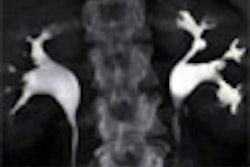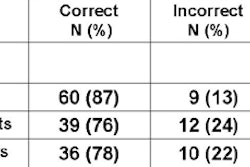ORLANDO, FL - SPECT/CT has the potential to enhance myocardial perfusion SPECT (MPS) by providing simultaneous coronary calcium measurements and, when appropriate, CT coronary angiography (CTA), according to a study presented Monday at the Academy of Molecular Imaging (AMI) meeting.
MPS is well-established as a clinical method for detecting and localizing myocardial tissue damage, and revealing areas of persistent cellular injury. CT is rapidly evolving as the most accurate noninvasive method for the early detection of coronary calcification; however, it cannot detect stenoses in densely calcified plaque.
"By allowing visualization of stenoses, the addition of CTA to MPS could eliminate the SPECT problem of occasionally missing patients with advanced disease and balanced reduction of blood flow," said Dr. Daniel Berman, medical director of the artificial intelligence in medicine program and director of cardiac imaging and also nuclear cardiology at Cedars-Sinai Medical Center in Los Angeles.
Berman presented an overview of the current role played by CT and SPECT in discovering coronary artery disease, and offered his insights on the part hybrid SPECT/CT imaging might play in detecting the disease.
MPS has a strong role in guiding patient management with a high technical success rate approaching nearly 100%, according to Berman. It provides objective measurements for perfusion and function, and is highly accurate for assessing the risk of cardiac death. In addition, it identifies those patients likely to benefit from revascularization, and is widely used by invasive cardiologists to determine the need to consider percutaneous coronary intervention (PCI).
"SPECT gives information about function, as well as about perfusion," Berman said. But SPECT's limitations include an inability to detect early atherosclerosis and a tendency to underestimate the extent of coronary artery disease, he noted.
"Just having a normal nuclear scan does not mean that you don't have atherosclerosis," he said.
The use of CT for coronary calcification detection has demonstrated a strong quantitative relationship between the coronary calcium score and the plaque burden on the patient, Berman said. He maintained that it is the most accurate noninvasive test for early detection, with an abnormal study implying coronary atherosclerosis. He noted that it has a high sensitivity (≥ 50%) for detecting angiographic stenosis, and is likely to become widely utilized if the procedure is reimbursed by the Centers for Medicare and Medicaid Services (CMS).
Berman observed that CT's drawbacks are that it provides no direct information regarding stenosis, and that it also offers no information on the benefit of revascularization.
Hybrid SPECT/CT imaging in coronary artery disease has the potential to optimize attenuation correction and provide coronary calcium scanning in all patients undergoing an MPS, Berman said. In addition, it has the possibility for combining an MPS with CTA and the potential for characterizing plaque.
"By assessing the functional consequences of stenosis, rest/stress MPS studies performed as a routine in conjunction with CT coronary angiography could allow the latter to be useful even in patients with dense coronary plaque," he said.
He said he foresees a key role for the technology in the emergency department, or in outpatient settings where there are space limitations, as well as other areas where space is at a premium.
Berman observed that the need for simultaneous -- compared with sequential -- SPECT/CT coronary artery disease assessment in current applications has not been demonstrated. Also, in regard to CTA, there is a need for the fastest CT technology with the highest resolution and coverage that is not present in the latest iteration of hybrid SPECT/CT systems, which lag one generation behind current standalone CT equipment, he said.
However, because SPECT/CT is so new, there are workflow and cost-effectiveness questions that need to be answered. For example, Berman asked: Would it be possible to attenuation map data from a standalone CT to a SPECT study, rather than conduct a simultaneous SPECT/CT exam? Also, is it more effective to have a standalone CT and SPECT study conducted with selected patients sent for a second test versus SPECT/CT imaging?
"Large databases with patients containing data regarding coronary calcium, coronary stenosis, and myocardial ischemia, using SPECT/CT are needed to determine whether this hybrid approach will prove cost-effective," Berman said.
By Jonathan S. Batchelor
AuntMinnie.com staff writer
March 22, 2005
Related Reading
MDCT maybe equivalent to MRI, tops echo and SPECT for heart function, February 15, 2005
ECG and peripheral arterial disease identify SPECT candidates, January 11, 2005
SPECT reveals deterioration in acute SAH patients with vasospasm, October 22, 2004
SPECT shows promise in diagnosing Parkinson's, October 12, 2004
SPECT/CT improves bladder cancer staging, management, May 12, 2004
Copyright © 2005 AuntMinnie.com




















